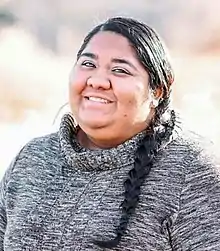Tamra Borchardt-Slayton
Tamra Borchardt-Slayton is a Paiute politician and the chairperson and leader of the Paiute Indian Tribe of Utah.
Tamra Borchardt-Slayton | |
|---|---|
 | |
| Chairperson of the Paiute Indian Tribe of Utah | |
| In office June 2017 – Current | |
| Personal details | |
| Born | April 3, 1987 Cedar City, UT |
| Spouse(s) | Michael Slayton |
| Children | Chanel and Carver |
| Residence(s) | Utah |
| Education | Southern Utah University and University of Minnesota, Duluth |
| Occupation | Politician |
Tenure
During her tenure as chairperson, the tribe launched the Paiute Educational Access Camp Experience, a summer camp at Southern Utah University that engages tribal youth around STEM. The program was launched with a grant from the Church of Jesus Christ of Latter-day Saints.[1]
Borchardt-Slayton was a major supporter of the Missing Murdered Indigenous Women and Girls Legislation for the State of Utah and was named as a member of the MMIWG Taskforce.[2] As a strong proponent for Missing and Murdered Indigenous Women, she was featured in Operation Lady Justice Activities and Accomplishments for the First Year Report.[3] Borchardt-Slayton is cited as stating:
For far too long, our communities and nations have grieved and mourned for our brothers, sisters, mothers, fathers, grandfathers, grandmothers, aunties, uncles, nieces and nephews. It's time for a clear federal commitment to fund tribal law enforcement, shelters, domestic violence and sexual assault organizations, and to enact policy change that will bring justice to victims, families of victims, survivors, and families of survivors.
— Tamra Borchardt-Slayton, Chairwoman for the Paiute Indian Tribe of Utah Listening Session, May 29, 2020
Borchardt-Slayton supports the renaming of Utah landmarks and sports teams that are offensive to Native peoples, such as those that use the word squaw, including legislative efforts by state representative.[4][5] She endorsed Deb Haaland for as secretary of the Department of the Interior.[6] However, she expressed frustration with the fact that Shipp did not consult with Native leaders before introducing the legislation to the state congress.[7]
References
- Weaver, Jennifer (5 June 2019). "PEACE camp offers Paiute high school students cultural history, STEM skills". KUTV. Retrieved 31 December 2020.
- Will, K. Sophie. "Stories of violence shared with Utah's Murdered and Missing Indigenous Women Task Force". The Spectrum.
- https://operationladyjustice.usdoj.gov/sites/g/files/xyckuh281/files/media/document/oljaccompfactsheet.pdf
- Webber, Megan (29 December 2020). "'It should have a Paiute name': Shivwits chime in on state bill proposing name changes of landmarks". Cedar City News. Retrieved 31 December 2020.
- Winslow, Ben (27 November 2020). "Bill introduced to rename Utah landmarks offensive to Native Americans". KSTU. Retrieved 31 December 2020.
- Groetzinger, Kate (27 November 2020). ""We just want what was promised": Utah Tribal Leaders Impressed By Biden's Plan For Indian Country". KUER. Retrieved 31 December 2020.
- Miller, Jessica (25 January 2020). "Utah tribal leaders protest legislation aimed to keep Native American mascots". The Salt Lake Tribune. Retrieved 31 December 2020.
External links
- Paiute Indian Tribe of Utah: Staff
- "Geneal Anderson, Leader of the Paiute Indian Tribe of Utah" by Tamra Borchardt-Slayton from Utah Women's History
- The Paiute Indian Tribe of Utah Current Staff Members and Biographies